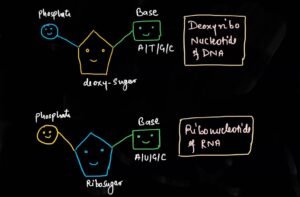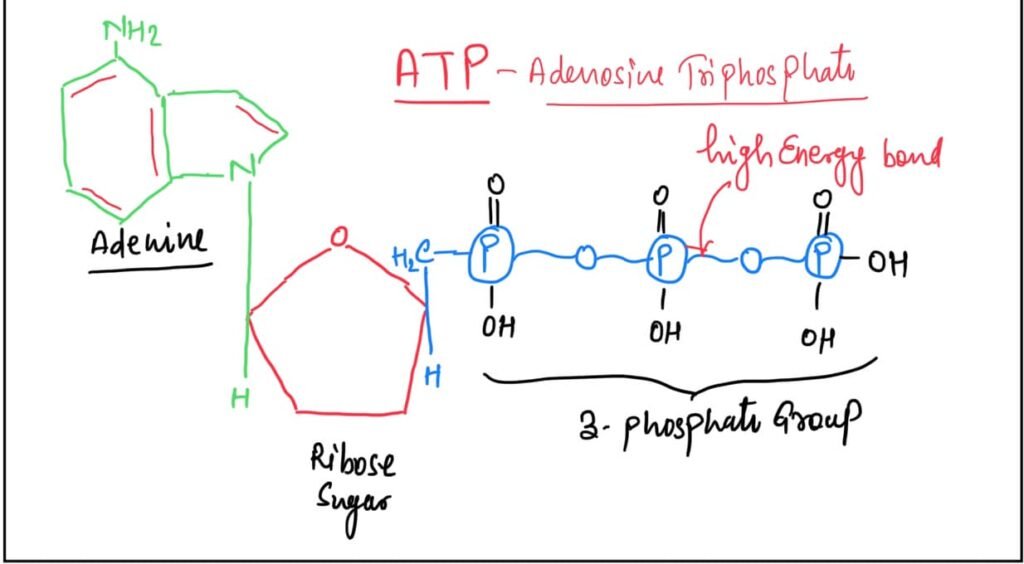Welcome to kashibiology.com
In this post we have to learn about the Structure & Functions of Nucleotides, Nucleosides & Higher Nucleotides for academic and medical competitive examination point of view.
Before starting this blog, first let’s see some important questions which are related to it.
What are Nucleotides?
Where are nucleotides found?
What are they made of?
How many types of nucleotides are there?
Why are these important?
If any other question related to this comes in your mind or has been missed in our blog, then you write it in the comment box. We will try our best to add it to our blog.
Now let’s start the blog with our first question?
Nucleotides
Nucleotide is called the structural unit nucleic acid, whether it is DNA or RNA. Nucleotides consist of three parts namely base, sugar and phosphate.
You may also like to read about some genetic diseases like Hemophilia & color blindness.
Nucleotides are monomers of nucleic acid, because all types of nucleic acids are found in all living organisms.(from virus to prokaryotes and from prokaryotes to complex multicellular organisms).
All of them contain Nucleic acid which are made up of nucleotides. One important point is that in viruses either DNA or RNA present but both together never present in any virus.
Therefore nucleotides can also be called the building block of nucleic acid, which means to say that if we talk about a house, which is made up of many bricks.
Similarly, nucleic acid (either DNA or RNA) is made up of many nucleotides.
You may also read to these post
Number of Nucleotides in Nucleic acid
The numbers of nucleotides vary according to the the organism to the organism and species to species such as bacteriophage 174 DNA contains contains 5386 nucleotides, while Bacteriophages lambda genome has 48502 base pairs, the bacteria Escherichia coli DNA has 4.6 into 10 to power 6 nucleotides.
Haploid content of human DNA has over 3 billion base pairs. if we talk about human diploid content of DNA, more than 6 billion nucleotides (more than 6 billion nucleotides or base pairs) are found in it.
Biomolecules which consist of nucleotides
As we earlier mentioned, Nucleotides are found in all types of nucleic acids.
Apart from this, our body uses ATP as an energy source. Cells of every living organism use ATP for the source of energy in almost all metabolic processes.
Hence ATP is also called the energy currency of cells. Other biological molecules similar in ATP like GTP (GTP-guanosine triphosphate), all of them actually consist of nucleotides.
However, ATP-adenosine triphosphate and GTP are called higher nucleotides because they contain more than one phosphate.
Structure of Nucleotides
Nucleotides are made up of three types of chemical compounds which are namely nitrogenous bases, five carbons containing pentose sugar, and Orthophosphoric acid (as phosphate group).
Nitrogenous bases and five-carbon sugars are joined together by glycosidic bonds to form nucleosides, and when nucleosides combine with phosphates to form nucleotides.

There are also five types of nitrogenous bases (adenine, guanine, cytosine, thymine and uracil).
Nitrogenous bases Adenine, guanine, cytosine and thymine are found in DNA, while adenine, guanine, cytosine and uracil are the nitrogenous bases in RNA.
There are two types of five-carbon pentose sugars, first is ribose sugar and second is deoxyribose sugar.
Ribose sugar is found in RNA, whereas deoxyribose sugar is found in DNA.
Nucleosides
When nitrogen bases and sugars combine with each other through glycosidic bonds, nucleosides are formed.
It means Nucleosides only contain pentose sugar and nitrogenous base.
The nucleosides found in RNA are called ribonucleosides (since RNA contains ribose sugar) and the nucleosides found in DNA are called deoxyribonucleosides, because DNA contains deoxyribose sugar.
On the basis of nitrogen base and sugar, nucleosides are of the following types.
Nucleosides or ribonucleosides found in RNA
- Adenosine (adenine and ribose sugar)
- Guanosine (guanine and ribose sugar)
- Cytidine (cytosine and ribose sugar)
- Uridine (uracil and ribose sugar)
Nucleosides or deoxyribose-nucleosides found in DNA
- Deoxyriboadenosine (adenine and deoxyribose sugar)
- Deoxyriboguanosine (guanine and deoxyribose sugar)
- Deoxyribothymidine (thymine and deoxyribose sugar)
- Deoxyribocytidine (cytosine and deoxyribose sugar)
Types of Nucleotides
Any types of Nucleotides consists of three components namely-
Base+sugar+phosphate (BSP)
Nucleotides are also divided into two types similar to nucleosides.
The first ribonucleotides found in RNA and the second deoxyribose-nucleotides found in DNA
Types of ribonucleotides
- Adenylic acid (adenine + ribose sugar + phosphate)
- Guanylic Acid (guanine + ribose sugar + phosphate)
- Cytidylic acid (cytosine + ribose sugar + phosphate)
- Uridylic acid (uracil + ribose sugar + phosphate)
Types of deoxyribonucleotides
- deoxyribose-adenylic acid (adenine + deoxyribose sugar + phosphate)
- deoxyribose-guanylic acid (guanine + deoxyribose sugar + phosphate)
- deoxyribose-thymidylic acid (thymine + deoxyribose sugar + phosphate)
- deoxyribose-cytidylic acid (cytosine + deoxyribose sugar + phosphate)
Higher class of Nucleotides
Most of the higher nucleotides are used as energy sources for various metabolic processes and also act as cofactors for many enzymes.
All the Higher nucleotides contain more than one phosphate group. Such as-
ATP-Adenosine Triphosphate- it is the most common higher nucleotides and used in all energy consuming metabolic processes.

In the cell system whenever a cell needs an energy source in any biochemical reactions ATP is ready to serve the purpose.
Some other are-
- ADP-adenosine diphosphate
- GDP-Guanosine triphosphate
- GTP-guanosine diphosphate
Role of Nucleotides
Since, nucleotides are the structural units of nucleic acids, and all types of nucleic acids are made up of nucleotides.
DNA or RNA cannot be imagined without nucleotides, and we all know that DNA is the genetic material inside all cellular organisms as well as many viruses.
DNA makes RNA and RNA makes proteins (according to central dogma of molecular biology)
At the same time, ATP is used as a source of energy in every type of metabolic process in the cells of our body.
Conclusion
Nucleotides make up DNA and RNA, and DNA and RNA control the functions of cells.
We know that cells perform all the basic functions of our body and in every living organism which are needed for survival.
So if there are no nucleotides then there will be no DNA or RNA and consequently the body will stop functioning.
How do you like this blog, do give your opinion in the comment box.
Thank you so much for giving your precious time

